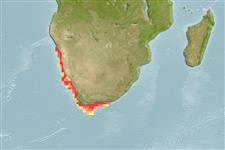Common names from other countries
Environment: milieu / climate zone / depth range / distribution range
Écologie
; profondeur 0 - 200 m (Ref. 4). Subtropical, preferred 18°C (Ref. 107945); 21°S - 37°S, 12°E - 26°E (Ref. 4)
Distribution
Pays | Zones FAO | Écosystèmes | Occurrences | Introductions
Southeast Atlantic: Namibia to South Africa.
Length at first maturity / Taille / Poids / Âge
Maturity: Lm 6.6, range 5 - ? cm Max length : 46.0 cm BL mâle / non sexé; (Ref. 4)
It has a maximum total body length of 46 cm and a carapace length of 18 cm. Maximum depth from Ref. 113432. Fisheries: The tails of this species are exported frozen in the shell, or peeled and canned. Experimental work on culture techniques for this species are underway in South Africa. Protective measures includes a size limit (carapace length 8.5 cm), a closed season from July 1 to October 31, bag limits for sports fishermen (2 specimens per day), and the prohibition of taking ovigerous females or soft shelled specimens (Ref. 4). Occurs at depths from 0 to 46 m of coastal waters and inhabits rocky bottoms, sometimes with patches of sand and mud (Ref. 4).
Life cycle and mating behavior
Maturité | Reproduction | Frai | Œufs | Fécondité | Larves
The males molt between September and December. In the females, molting occurs in April or May, after which copulation takes place. Ovigerous females are found from May to October (Ref. 4).
Holthuis, L.B. 1991. (Ref. 4)
Statut dans la liste rouge de l'IUCN (Ref. 130435)
statut CITES (Ref. 108899)
Not Evaluated
Not Evaluated
Utilisations par l'homme
Pêcheries: commercial
FAO - pêcheries: landings | FishSource | Sea Around Us
Outils
Sources Internet
Estimates based on models
Preferred temperature
(Ref.
115969): 14.6 - 19.5, mean 16.7 (based on 12 cells).
Résilience
Faible, temps minimum de doublement de population : 4,5 à 14 années (K=0.1-0.11).
Vulnérabilité
Moderate vulnerability (36 of 100).
